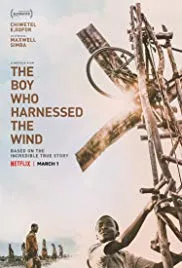Historical accuracy of The Boy Who Harnessed the Wind

Historical accuracy of The Boy Who Harnessed the Wind

Characters
William Kamkwamba
William Kamkwamba is the real person whose memoir the film is based on. The film accurately portrays his real-life story of building a wind turbine to bring power and water to his Malawian village during a famine.
Trywell Kamkwamba
Trywell is William's real father. The film accurately depicts his struggles as a farmer during the famine and his complex relationship with William, including initial skepticism and eventual pride.
Agnes Kamkwamba
Agnes is William's real mother. Her portrayal reflects the strength and support she provided to her family during immense hardship, as detailed in the memoir.
Annie Kamkwamba
Annie is William's real older sister. The film accurately depicts her presence in the family and includes a storyline reflecting her desire to continue education and escape the village's hardships.
Gilbert Wimbe
Gilbert Wimbe is William's real friend and the son of the village chief. His support for William and his role within the community dynamics are based on the real person described in the memoir.
Chief Wimbe
Based on the real Chief Wimbe of William's village, Kachokolo. His leadership role and response to the famine and political situation are depicted based on historical context and the memoir.
More characters
Edith Sikelo
This character represents the librarians who helped William access crucial information, particularly based on librarian Edith Sikelo who worked in the Malawi National Library Service branch William used.
Mike Kachigunda
Represents the teachers who influenced William, likely based specifically on his real science teacher, Mr. Kachigunda, who fostered his interest in science.
Charity
While perhaps not a specific individual named Charity, this character represents the various people William had to negotiate with or acquire parts from in the community to build his windmill.
Story
William Kamkwamba's story
The film is based on the true story of William Kamkwamba, a Malawian boy who built a windmill to generate electricity for his village. This central premise of the film is rooted in real events and William's own account.
The famine in Malawi
The film accurately depicts the devastating famine that struck Malawi in the early 2000s. This environmental crisis and its impact on William's village are central to the story.
William's expulsion from school
William's expulsion from school due to his family's inability to pay school fees is a true event. This event highlights the challenges faced by many children in impoverished communities.
William's resourcefulness and determination
The film portrays William's resourcefulness and determination to find a solution to his village's problems. His ingenuity and perseverance in building the windmill are accurately depicted.
The use of the library
William's use of the school library to learn about science and engineering is a true element of the story. This highlights the importance of education and access to knowledge.
The challenges of building the windmill
The film realistically portrays the challenges William faced in building the windmill, including limited resources, skepticism from his community, and technical difficulties. These obstacles are a key part of his journey.
The windmill's success
The film accurately depicts the success of William's windmill in generating electricity for his village. This achievement brought hope and improved living conditions for the community.
The role of William's father
The film portrays a complex relationship between William and his father, who initially disapproves of his unconventional ideas. While this captures the core conflict, some aspects of their relationship are dramatized for the film.
The role of traditional beliefs
The film acknowledges the role of traditional beliefs and practices in the village community, including the influence of the village chief and the challenges William faces in challenging traditional thinking.
Setting
The portrayal of the village community
The film effectively portrays the dynamics of the village community, including the traditions, the challenges, and the resilience of the people. The film captures the sense of community spirit and the impact of the famine.
The political context of Malawi
The film touches upon the political context of Malawi, including corruption and government policies that contribute to the famine. However, the film's primary focus is on William's story and the local community, not on broader political issues.
The depiction of education and its importance
The film highlights the importance of education and its potential to empower individuals and communities. William's thirst for knowledge and his belief in the power of science are central to the story.
